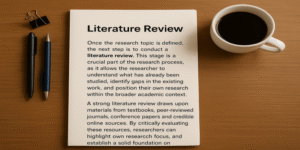In today’s rapidly evolving and highly competitive business landscape, empathy in the workplace has become an indispensable element of organisational success. As workplaces grow more diverse, interconnected, and fast-paced, the ability to understand and respond sensitively to others’ emotions and experiences is increasingly recognised as a vital leadership and interpersonal skill. Empathy is not only an ethical imperative but also a strategic asset, influencing employee engagement, retention, innovation, and performance (Goleman, 1995).
This article explores the importance of empathy in organisational settings and analyses seven key principles—including Help Over Blame, Kindness Over Indifference, and Listening Over Speaking—that form the foundation of an empathetic organisational culture. When applied effectively, these principles help create an environment of trust, collaboration, and psychological safety, driving both individual and collective growth.
1.0 The Importance of Empathy in the Workplace
Empathy refers to the capacity to understand and share another person’s emotional state (Ickes, 1997). It encompasses both cognitive empathy—the intellectual ability to see things from another’s perspective—and emotional empathy, which allows individuals to resonate with others’ feelings. In the workplace, empathy enhances communication, problem-solving, and teamwork by fostering mutual respect and understanding.
According to Goleman (1995), empathy is one of the five dimensions of emotional intelligence (EI)—alongside self-awareness, self-regulation, motivation, and social skills. EI enables individuals, particularly leaders, to recognise emotions in themselves and others and to use this awareness to guide thinking and behaviour. Leaders who exhibit empathy tend to make more balanced, inclusive, and ethical decisions, as they consider the needs and perspectives of their team members (Boyatzis & McKee, 2005).
Empathy is also essential to organisational well-being. A culture rooted in empathy leads to reduced burnout, higher morale, and increased engagement (Reiss, 2018). Employees who feel understood are more motivated to contribute, fostering loyalty and reducing turnover rates. For instance, companies such as Microsoft, under the leadership of Satya Nadella, have embraced empathy as a core leadership philosophy—resulting in improved collaboration, innovation, and organisational performance (Harvard Business Review, 2020).
2.0 Key Principles of Empathy at Work
Empathy can be embedded into the workplace through intentional action. The following seven key principles serve as practical frameworks for cultivating an empathetic organisational culture.
2.1 Help Over Blame
When errors occur, workplaces often default to assigning blame, creating fear and defensiveness. However, empathetic workplaces prioritise help and support over criticism. This principle encourages a culture of learning rather than punishment, where employees feel safe to take risks, make mistakes, and share innovative ideas.
Edmondson (1999) introduced the concept of psychological safety, describing it as a climate in which individuals feel safe to express themselves without fear of negative repercussions. In such environments, employees are more likely to admit errors and seek assistance, leading to continuous improvement and innovation. For example, Google’s Project Aristotle found that teams with high psychological safety outperformed others, demonstrating that empathy-driven support systems enhance both creativity and performance.
2.2 Kindness Over Indifference
Empathy begins with genuine kindness—a recognition of others’ humanity beyond their job roles. Demonstrating care for employees’ well-being fosters trust and emotional connection. When leaders show concern for personal as well as professional challenges, employees are more likely to engage fully and remain committed to organisational goals.
Kindness also reduces stress and emotional fatigue, which are significant barriers to productivity. Research by Edmondson (1999) and Neff (2011) highlights that compassionate environments improve emotional resilience, enabling employees to thrive. A simple example is Salesforce, where CEO Marc Benioff encourages leaders to check in with employees about their well-being—a practice that has become integral to the company’s empathetic culture.
2.3 Listening Over Speaking
One of the most powerful expressions of empathy is active listening. Instead of formulating responses while others speak, empathetic leaders and colleagues focus on understanding. According to Rogers and Farson (1957), active listening involves paying full attention, reflecting on what is said, and withholding judgement. This fosters trust and mutual respect, and ensures that employees feel heard and valued.
In conflict situations, active listening allows for deeper understanding of the root causes rather than surface-level disagreements. It is particularly crucial for inclusive workplaces, ensuring that diverse voices are represented and respected. For example, IBM’s “listening sessions” provide safe spaces for employees from different backgrounds to share experiences, resulting in stronger inclusivity and equity policies.
2.4 Flexibility Over Rigidity
Modern organisations operate in environments of constant change. Demonstrating flexibility over rigidity—by adapting policies or practices to individual needs—reflects genuine empathy. Flexibility might involve accommodating different working styles, remote work, or flexible schedules.
Kossek et al. (2014) found that flexible work arrangements lead to higher job satisfaction, better work-life balance, and lower turnover. Empathetic organisations recognise that employees are not uniform and that understanding personal circumstances enhances performance. For example, during the COVID-19 pandemic, many companies, such as Unilever and PwC, offered flexible working hours and mental health days, strengthening employee trust and well-being.
2.5 Understanding Over Fixing
Empathy involves understanding before acting. Leaders often rush to solve problems without grasping the emotional context behind them. However, Ickes (1997) introduced the concept of empathic accuracy—the ability to accurately infer others’ emotions—which is crucial for meaningful support.
Taking time to listen and understand an employee’s perspective leads to better long-term solutions. For instance, if an employee struggles with performance, an empathetic leader first seeks to understand potential personal or environmental challenges rather than offering quick technical fixes. This approach fosters emotional connection and loyalty.
2.6 Curiosity Over Judgement
Curiosity is the foundation of empathy. Instead of making assumptions, empathetic individuals engage in inquiry-driven dialogue—asking questions to understand motivations and feelings. This mindset cultivates open-mindedness and helps reduce bias.
According to Dweck (2006), adopting a growth mindset—remaining curious and open to learning—enables leaders to view differences as opportunities rather than threats. Encouraging curiosity helps organisations become more innovative and inclusive, as diverse ideas are welcomed and explored rather than dismissed.
2.7 Patience Over Pressure
In performance-driven environments, the pressure to deliver results can undermine empathy. Yet, patience allows for human variability, acknowledging that learning, creativity, and problem-solving take time. Empathetic leaders understand that supporting employees’ development at their own pace leads to more sustainable outcomes.
A culture of patience encourages reflection, learning, and improvement. For example, tech companies such as Atlassian have adopted “no-blame retrospectives,” where teams discuss challenges constructively rather than rushing to assign fault. This patient and reflective culture fosters continuous growth and collaboration.
3.0 Building a Culture of Empathy: Strategic Implications
Incorporating empathy into the workplace is both a moral and strategic imperative. Research consistently demonstrates that empathy improves employee engagement, creativity, and retention (Reiss, 2018; Goleman, 1998). Empathy is also a hallmark of effective leadership. As Kouzes and Posner (2012) argue, leaders who connect emotionally with their teams foster trust and motivation, creating conditions for exceptional performance.
Organisations can strengthen empathy by providing leadership training, team-building exercises, and employee well-being programmes that prioritise emotional awareness. Embedding empathy into recruitment, evaluation, and leadership frameworks ensures it becomes a sustainable part of corporate culture. The most successful companies today—from Google to Microsoft—demonstrate that empathy and performance are not opposites but mutually reinforcing.
Empathy is more than a personal virtue—it is the lifeblood of modern organisational culture. By adopting principles such as Help Over Blame, Kindness Over Indifference, and Listening Over Speaking, organisations cultivate environments of psychological safety, trust, and collaboration. Empathy-driven workplaces not only enhance individual well-being but also unlock collective potential, enabling innovation and sustainable success. In an age defined by digital transformation and human complexity, empathy remains the enduring bridge between performance and purpose.
References
Boyatzis, R. E. and McKee, A. (2005) Resonant Leadership: Renewing Yourself and Connecting with Others Through Mindfulness, Hope, and Compassion. Boston: Harvard Business Press.
Dweck, C. S. (2006) Mindset: The New Psychology of Success. New York: Random House.
Edmondson, A. C. (1999) ‘Psychological Safety and Learning Behaviour in Work Teams’, Administrative Science Quarterly, 44(2), pp. 350–383.
Goleman, D. (1995) Emotional Intelligence: Why It Can Matter More Than IQ. London: Bloomsbury.
Goleman, D. (1998) Working with Emotional Intelligence. New York: Bantam Books.
Harvard Business Review (2020) ‘Satya Nadella on Empathy and the Power of Learning’. [Online] Available at: https://hbr.org [Accessed 15 June 2024].
Ickes, W. (1997) Empathic Accuracy. New York: Guilford Press.
Kossek, E. E., Ruderman, M. N., Braddy, P. W. and Hannum, K. M. (2014) ‘Work–Nonwork Boundary Management Profiles: A Person-Centred Approach’, Journal of Vocational Behavior, 85(2), pp. 226–239.
Neff, K. (2011) Self-Compassion: The Proven Power of Being Kind to Yourself. New York: HarperCollins.
Reiss, H. (2018) The Empathy Effect: Seven Neuroscience-Based Keys for Transforming the Way We Live, Love, Work, and Connect Across Differences. Boulder, CO: Sounds True.
Rogers, C. R. and Farson, R. E. (1957) Active Listening. Chicago: Industrial Relations Center, University of Chicago.









